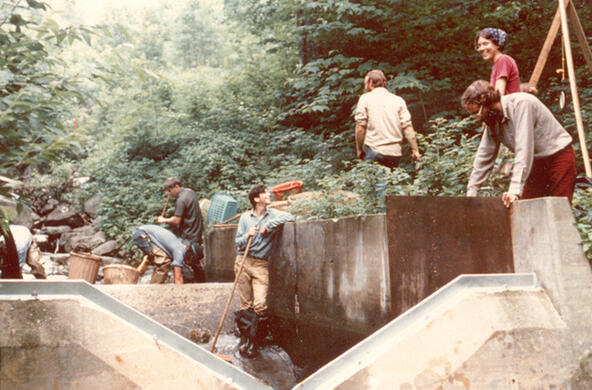Cary Institute scientists have provided leadership in acid rain research, but acid rain is not limited to our area—it occurs widely across the eastern United States, Europe, China, and other industrialized areas around the world. How does rain become acidic and why do we care?
The pH scale is used to express the acidity of water. Pure water has a neutral pH of 7.0; it has an equal number of hydrogen ions (H+) and hydroxyl ions (OH-). When we mix other substances into water, its pH can change. Acidic solutions have more H+ and a lower pH, and alkaline solutions have more OH- and a higher pH.
In our area, due to acids that occur naturally in the atmosphere, the background pH of rain is between 5.0 and 5.5. Human activities can cause pH levels to drop lower. Coal-fired power plants and motor vehicles release nitrogen oxides and sulfur dioxide into the atmosphere. When rain passes through these pollutants, nitric and sulfuric acids form, and pH levels can dip below 3.0.
The pH scale is not linear; rain with a pH of 3.0 is ten times more acidic than rain at pH 4.0 and 10,000 times more acidic than rain at pH 7.0.
Streams in the eastern U.S. tend to be naturally somewhat acidic, but this does not mean that they are immune to acid rain. Human inputs can magnify natural levels of acidity. When acidic runoff enters streams and lakes, it can be toxic to aquatic animals, including fish. Most fish are unable to survive when the pH drops below 5.0.
In excess, the hydrogen ions that cause acidity also leach important nutrients, such as calcium and potassium, from the plants and soil. This can cause nutrient deficiencies that stunt forest growth. Birds may also suffer. In some areas, calcium loss is so severe that birds have a difficult time ingesting enough of this important mineral in their diet. As a result, they are unable to form eggshells during the spring nesting period.
For some time now, the scientific community has had solid evidence that acid precipitation is linked to the widespread burning of coal and oil for power and transportation. Resulting emissions, delivered to the landscape via rain, snow, particles, and gases, have overwhelmed natural soil acidity and caused excessive leaching of soil nutrients. At the same time, we've reduced the amount of acid-neutralizing substances in the atmosphere.
As dirt roads were paved and particulate scrubbers were added to smokestacks, calcium-rich particle emissions have been reduced. To some extent, our efforts to clean up one form of air pollution (i.e., particulates and dust) have exacerbated the impact of another (acidic gases). But most small particles aren't good for us either, so it is important that we strive to reduce the emission of both particles and acidic substances into the atmosphere.
In the past few years, acid rain has not been making newspaper headlines. In part, this stems from the success of the Clean Air Act, which has helped reduce sulfur dioxide emissions from coal-burning power plants.
But the long-term data are clear— acid rain has not disappeared. An important next step is minimizing nitrogen oxide emissions. These acidic pollutants are emitted by cars and trucks as well as power plants. The good news is that sound energy use and fossil fuel conservation will help minimize both acid rain and the ill-effects of global climate change.







